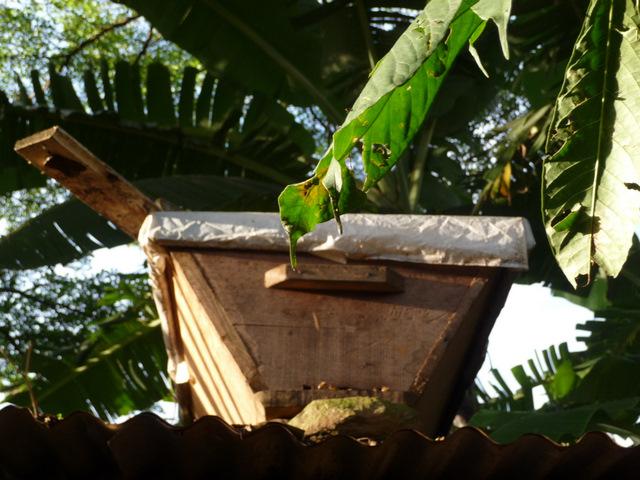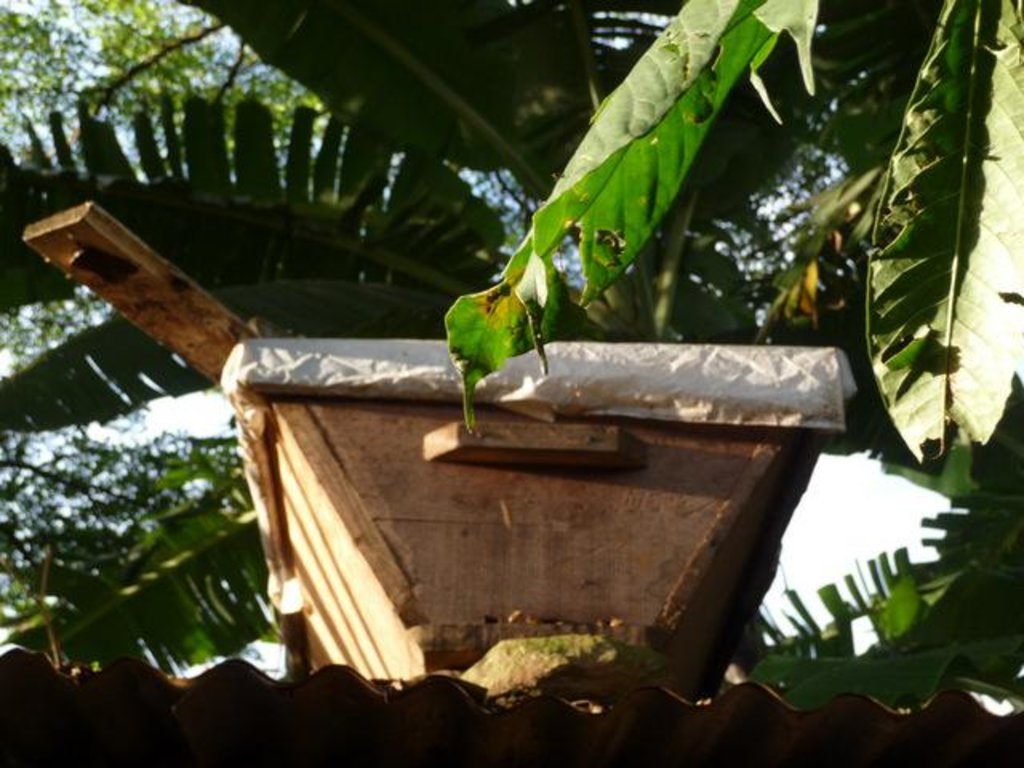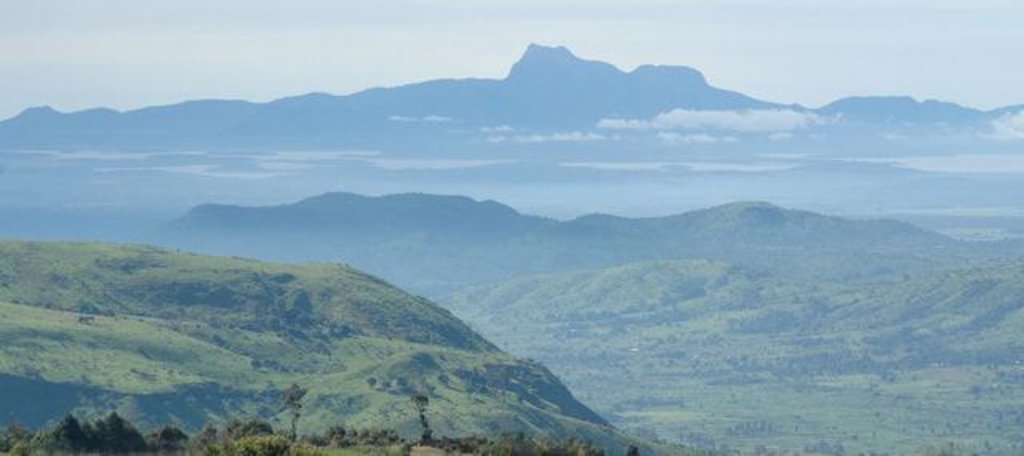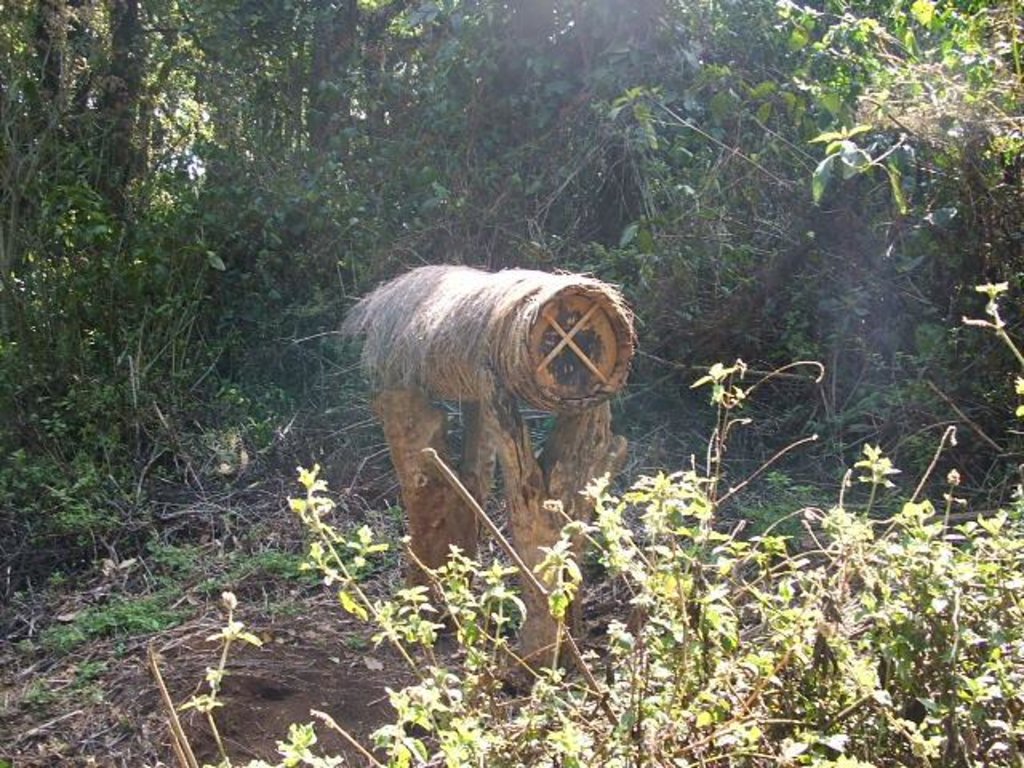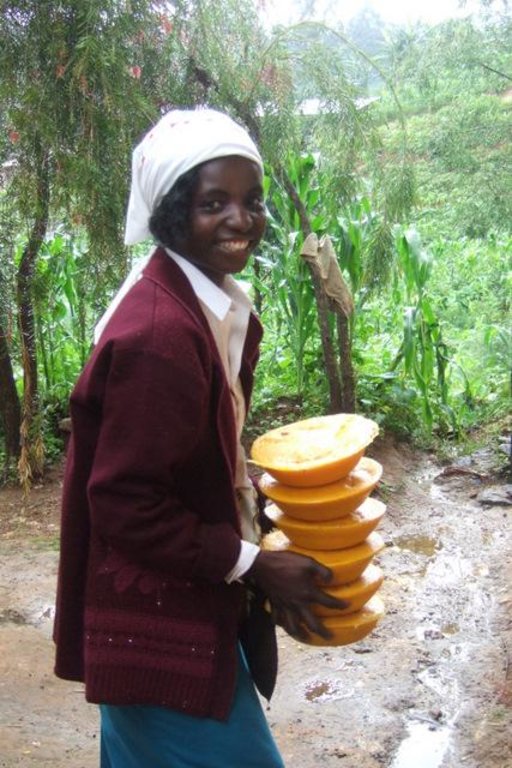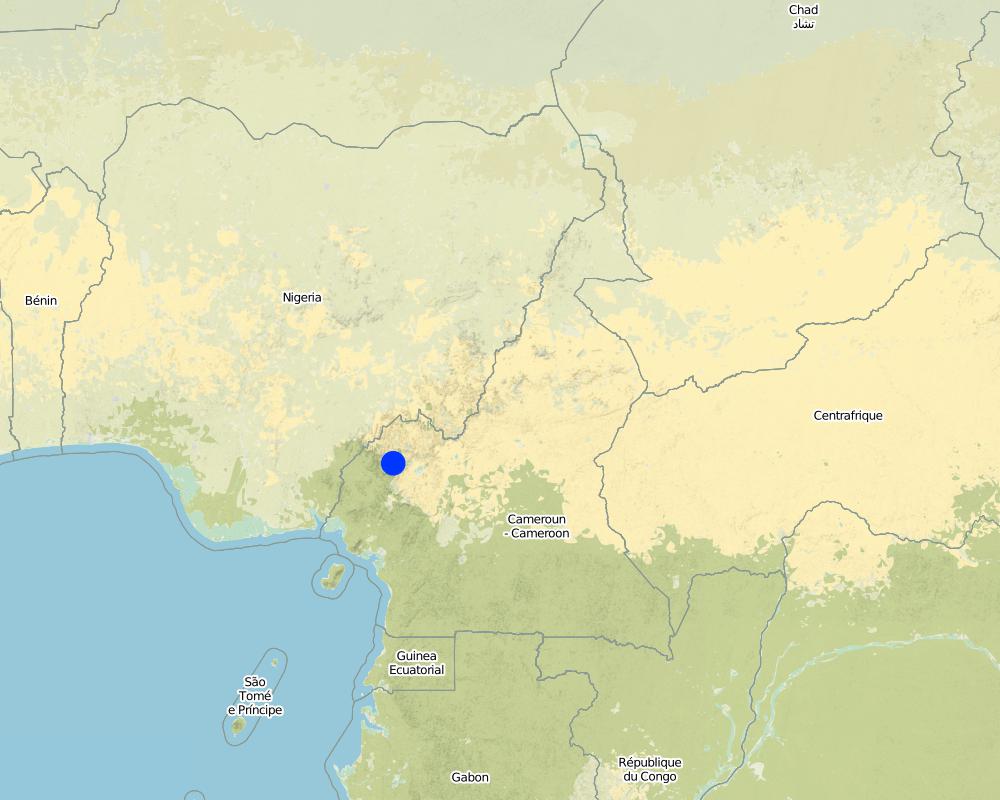Forest Beekeeping [喀麦隆]
- 创建:
- 更新:
- 编制者: Unknown User
- 编辑者: –
- 审查者: Fabian Ottiger, Alexandra Gavilano
technologies_1360 - 喀麦隆
查看章节
全部展开 全部收起1. 一般信息
1.2 参与该技术评估和文件编制的资源人员和机构的联系方式
关键资源人
SLM专业人员:
Verina Ingram
Cifor Cameroon
喀麦隆
有助于对技术进行记录/评估的项目名称(如相关)
Book project: SLM in Practice - Guidelines and Best Practices for Sub-Saharan Africa (SLM in Practice)有助于对技术进行记录/评估的机构名称(如相关)
CIFOR Center for International Forestry Research (CIFOR) - 印度1.3 关于使用通过WOCAT记录的数据的条件
编制者和关键资源人员接受有关使用通过WOCAT记录数据的条件。:
是
1.5 参考关于SLM方法(使用WOCAT记录的SLM方法)的调查问卷
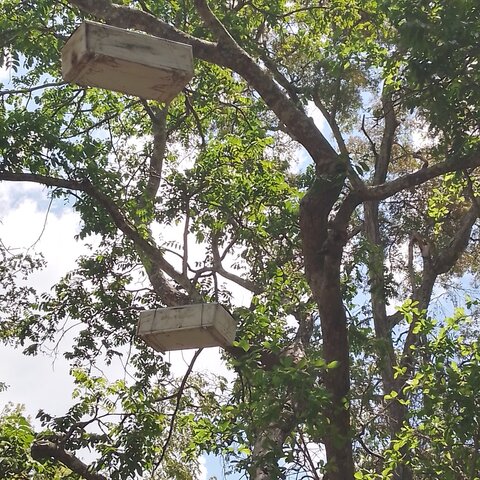
BEEKEEPING FOR CONSERVATION OF NATURAL TREES AND FOREST … [坦桑尼亚联合共和国]
Beekeeping is an activity which involves maintenance of bee colonies by using man-made hives within a selected forest area which provides the required feed and habitat resources required by bees. Through beekeeping, trees are conserved as they provide flowers hence ensuring feeds for bees. Beekeeping is used as an approach …
- 编制者: LINDA SHIO
2. SLM技术的说明
2.1 技术简介
技术定义:
Apiculture (beekeeping) is a traditional practice providing a high number of non-timber forest products.
2.2 技术的详细说明
说明:
Apiculture (beekeeping) has been traditionally practiced for at least a century in Cameroon; with forest-based apiculture increasing in the last 2 decades. The ancient art of honey hunting, and the more recent apiculture and its products like honey, wax, propolis, bee venom and royal jelly, are examples of non-timber forest products (NTFP). A number of projects were supporting production and marketing, due to the conservation and development benefits of beekeeping. Beekeeping has low establishment costs and requires little land or labour, and by providing a suitable environment for the hives in a favourable location (i.e. forest with a range of melliferous trees and plants and sufficient water available year round) it is possible to sustainably harvest a range of bee products on an annual basis. For processing of the honey, the honeycomb is filtered and honey can be bottled and sold. Higher value is obtained by packaging and labelling. In Cameroon up to 4 US$/kg can be achieved for good quality honey. It can also be sold for industrial use – for example bakeries, sweets. If combs are washed, the resulting honey-water can be made into wine. Wax needs to be melted and cleaned, and can then be sold ‘raw’ for a price of about 2-6 US$/kg, or further processed into candles, soaps and creams. In Cameroon, the consumer market is expanding and a small, niche export market for high quality, certified organic and fair trade wax, honey and propolis, is emerging. The exports to Europe and the US require quality assurance schemes that entail costs, expertise and collaboration between government and beekeepers. The number of hives per bee-farmer can vary considerably from a few up to 150 hives. Approximately 15 hives can be installed per hectare. Beekeepers can be good ‘guardians of the forests’, because they know that the forest provides both forage and water for the bees, and the water and materials needed to make hives and process apiculture products.
2.3 技术照片
2.5 已应用该技术的、本评估所涵盖的国家/地区/地点
国家:
喀麦隆
区域/州/省:
Mount Oku region, Mountainous forests of Northwest Cameroon
有关地点的进一步说明:
Bui, Boyo, Mezam and Donga Mantung divisions
Map
×2.6 实施日期
如果不知道确切的年份,请说明大概的日期:
- 50多年前(传统)
2.7 技术介绍
详细说明该技术是如何引入的:
- 作为传统系统的一部分(> 50 年)
3. SLM技术的分类
3.1 该技术的主要目的
- 创造有益的经济影响
3.2 应用该技术的当前土地利用类型

森林/林地
- Sustainable rainforest management
产品和服务:
- 水果和坚果
- 其它森林产品
注释:
Apiculture (beekeeping)
Major land use problems (land users’ perception): Deforestation, Overuse of natural ressources
3.5 该技术所属的SLM组
- 养蜂、养殖业、家禽业、养兔业、养蚕业等
3.6 包含该技术的可持续土地管理措施

管理措施
- M3:根据自然和人文环境进行布局
注释:
Main measures: management measures
3.7 该技术强调的主要土地退化类型

生物性退化
- Bc:植被覆盖的减少
注释:
Main type of degradation addressed: Bc: reduction of vegetation cover
Main causes of degradation: deforestation / removal of natural vegetation (incl. forest fires), over-exploitation of vegetation for domestic use
3.8 防止、减少或恢复土地退化
具体数量名该技术与土地退化有关的目标:
- 防止土地退化
4. 技术规范、实施活动、投入和成本
4.1 该技术的技术图纸
技术规范(与技术图纸相关):
Technical knowledge required for field staff / advisors: moderate
Technical knowledge required for land users: low
Main technical functions: Indirectly deforestation / overuse of natural forests
Layout change according to natural and human environment
4.3 技术建立活动
| 活动 | 时间(季度) | |
|---|---|---|
| 1. | Construction of hives (traditional or modern, depending on skills and availability/ cost of materials) | |
| 2. | Place hives on forest trees or on stands, above the level of fires, as well as away from ant and termite colonies | |
| 3. | None |
注释:
Establishing activities: extra information Harvesting of honey combs often done at night to minimize disturbance of the bees Comb washing water can be used in honey beer or wine in lidded buckets / basins or bottles or using as fermentation airlock
4.4 技术建立所需要的费用和投入
| 对投入进行具体说明 | 单位 | 数量 | 单位成本 | 每项投入的总成本 | 土地使用者承担的成本% | |
|---|---|---|---|---|---|---|
| 劳动力 | Labour | ha | 1.0 | 40.0 | 40.0 | 100.0 |
| 设备 | Tools | ha | 1.0 | 10.0 | 10.0 | |
| 设备 | Smoker | ha | 1.0 | 15.0 | 15.0 | |
| 设备 | Buckets | ha | 1.0 | 12.0 | 12.0 | |
| 设备 | Filtering materials | ha | 1.0 | 10.0 | 10.0 | |
| 设备 | Bottles | ha | 1.0 | 10.0 | 10.0 | |
| 施工材料 | Replacement/repair hive, filte | ha | 1.0 | 15.0 | 15.0 | |
| 技术建立所需总成本 | 112.0 | |||||
| 技术建立总成本,美元 | 112.0 | |||||
4.5 维护/经常性活动
| 活动 | 时间/频率 | |
|---|---|---|
| 1. | Wait for natural colonisation or capture a swarm and transfer to hive | |
| 2. | Regular (weekly or monthly) checking of hive conditions to ensure that the colony is not disturbed by pests or damaged through wind/ rain. In drought periods a shallow bucket of water is provided to the bees. Reparation activities if needed. | |
| 3. | Harvest honey (as soon as sufficient is available), wax and propolis, using a 'smoker' and clean bucket, leaving brood combs to maintain the colony (usually annually at end of rainy and/or flowering season; depends on location) | |
| 4. | Filter honey from combs to separate honey and wax; then bottle and pack | |
| 5. | Process wax (e.g. washing comb and boiling in water or solar melting box) and melt into moulds, using a press or centrifuge. |
4.6 维护/经常性活动所需要的费用和投入(每年)
| 对投入进行具体说明 | 单位 | 数量 | 单位成本 | 每项投入的总成本 | 土地使用者承担的成本% | |
|---|---|---|---|---|---|---|
| 劳动力 | Labour | ha | 1.0 | 60.0 | 60.0 | 100.0 |
| 施工材料 | Replacement/repair hive, filte | ha | 1.0 | 5.0 | 5.0 | 100.0 |
| 技术维护所需总成本 | 65.0 | |||||
| 技术维护总成本,美元 | 65.0 | |||||
注释:
Machinery/ tools: machete, axe, knife
5. 自然和人文环境
5.1 气候
年降雨量
- < 250毫米
- 251-500毫米
- 501-750毫米
- 751-1,000毫米
- 1,001-1,500毫米
- 1,501-2,000毫米
- 2,001-3,000毫米
- 3,001-4,000毫米
- > 4,000毫米
有关降雨的规范/注释:
2000-2400
农业气候带
- 半湿润
Thermal climate class: tropics
5.2 地形
平均坡度:
- 水平(0-2%)
- 缓降(3-5%)
- 平缓(6-10%)
- 滚坡(11-15%)
- 崎岖(16-30%)
- 陡峭(31-60%)
- 非常陡峭(>60%)
地形:
- 高原/平原
- 山脊
- 山坡
- 山地斜坡
- 麓坡
- 谷底
垂直分布带:
- 0-100 m a.s.l.
- 101-500 m a.s.l.
- 501-1,000 m a.s.l.
- 1,001-1,500 m a.s.l.
- 1,501-2,000 m a.s.l.
- 2,001-2,500 m a.s.l.
- 2,501-3,000 m a.s.l.
- 3,001-4,000 m a.s.l.
- > 4,000 m a.s.l.
关于地形的注释和进一步规范:
Altitudinal zone: 1501-2000 m a.s.l. (Mountain forests)
Landforms: Also valley floors
5.3 土壤
平均土层深度:
- 非常浅(0-20厘米)
- 浅(21-50厘米)
- 中等深度(51-80厘米)
- 深(81-120厘米)
- 非常深(> 120厘米)
土壤质地(表土):
- 细粒/重质(粘土)
如有可能,附上完整的土壤描述或具体说明可用的信息,例如土壤类型、土壤酸碱度、阳离子交换能力、氮、盐度等。:
Soil texture: FIne/heavy (lateritic clay)
5.5 生物多样性
物种多样性:
- 高
5.6 应用该技术的土地使用者的特征
生产系统的市场定位:
- 混合(生计/商业)
说明土地使用者的其他有关特征:
Difference in the involvement of women and men: small to medium scale, very poor to average level of wealth; individuals, groups cooperative or employee; cooperatives are mainly used for marketing products and/ or buying material
Population density: 50-100 persons/km2
Relative level of wealth: average, poor, very poor
5.8 土地所有权、土地使用权和水使用权
土地使用权:
- 社区(有组织)
注释:
Land ownership: community forest or individual (titled and not titled)
Land use rights: legal form of community management; many people keep bees by the forest edge on their farms, usually on privately owned land
Land ownership: communal / village, individual, not titled, individual, titled
6. 影响和结论性说明
6.1 该技术的现场影响
社会经济效应
收入和成本
农业收入
注释/具体说明:
Increased income from honey, wax and propolis sales
社会文化影响
食品安全/自给自足
注释/具体说明:
Subsistence use and sales of apiculture products e.g. wax / honey / propolis soaps, cosmetic, creams
健康状况
注释/具体说明:
Own consumption of honey food and medicine and propolis (medicinal use)
生态影响
生物多样性:植被、动物
植被覆盖
注释/具体说明:
Conservation of forests and particularly melliferous trees as well as pollination of forests and crops
生物量/地上C
注释/具体说明:
Conservation of forests and particularly melliferous trees as well as pollination of forests and crops
植物多样性
注释/具体说明:
Conservation of forests and particularly melliferous trees as well as pollination of forests and crops
有益物种
6.2 该技术的场外影响已经显现
Pollination
注释/具体说明:
Pollination in area approx 4-6 km from hive
6.3 技术对渐变气候以及与气候相关的极端情况/灾害的暴露和敏感性(土地使用者认为的极端情况/灾害)
注释:
Unknown sensitivity of bees to climatic extremes; resilience of bees is assumed, but changes in honey quality and quantity depending on forage available with changes in forest cover/ structure
6.4 成本效益分析
技术收益与技术建立成本相比如何(从土地使用者的角度看)?
短期回报:
轻度消极
长期回报:
积极
技术收益与技术维护成本/经常性成本相比如何(从土地使用者的角度看)?
短期回报:
中性/平衡
长期回报:
积极
注释:
Initial investment in hives often recouped in 2-5 years, depending on level of production
6.5 技术采用
如若可行,进行量化(住户数量和/或覆盖面积):
4500 households and 100% of the area covered
在所有采用这项技术的人当中,有多少人是自发的,即未获得任何物质奖励/付款?:
- 91-100%
注释:
100% of land user families have adopted the Technology without any external material support
4500 land user families have adopted the Technology without any external material support
There is a strong trend towards spontaneous adoption of the Technology
Comments on adoption trend: Established and knowledgeable beekeepers in a community aid dissemination of technology and spontaneous adoption.
6.7 该技术的优点/长处/机会
| 编制者或其他关键资源人员认为的长处/优势/机会 |
|---|
| Protection of the forest because beekeepers are aware of the benefits they receive from this ecosystem |
6.8 技术的弱点/缺点/风险及其克服方法
| 土地使用者认为的弱点/缺点/风险 | 如何克服它们? |
|---|---|
| Pests destroy hives / eat honey (e.g. honey badgers, ants, termites, civets) | relocate hives, stronger/ different hive construction, regular checks |
| Theft of hives | patrol forest, make agreements in community, locate hives near farms/houses, chain or lock hive. |
| Low production | relocate hives to more forested areas, ensure hive located with < 2 km from water source in dry season |
| Bush fires can destroy hive | agreements with farmers/pastoralists about bush fire patrols in dry season, create fire breaks around hive and support trees |
| Rain can destroy hive | use of metal, sheet, grass, raffia or wood as protective ‘roof’, place in a ‘’bee house’’ of locally constructed materials, or under a simple shelter, and experiment with different designs |
链接和模块
全部展开 全部收起链接

BEEKEEPING FOR CONSERVATION OF NATURAL TREES AND FOREST … [坦桑尼亚联合共和国]
Beekeeping is an activity which involves maintenance of bee colonies by using man-made hives within a selected forest area which provides the required feed and habitat resources required by bees. Through beekeeping, trees are conserved as they provide flowers hence ensuring feeds for bees. Beekeeping is used as an approach …
- 编制者: LINDA SHIO
模块
无模块


